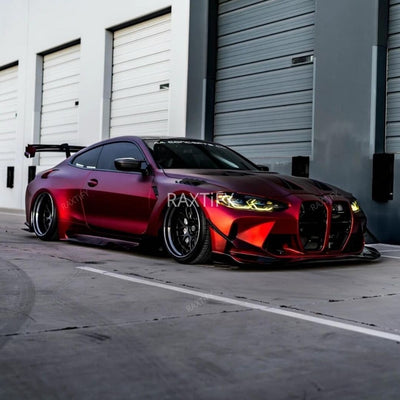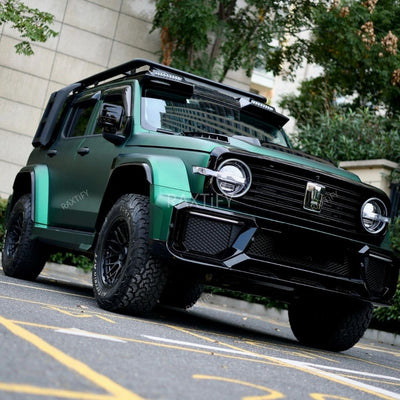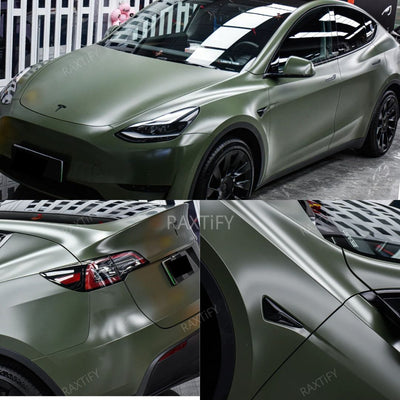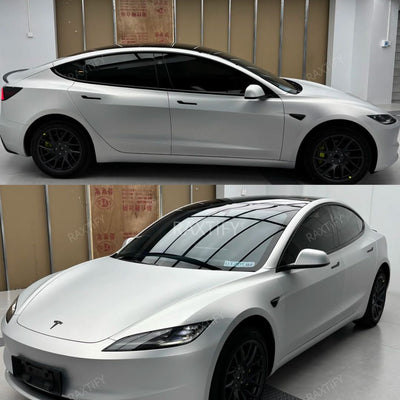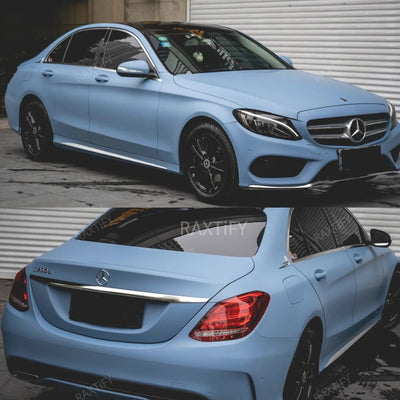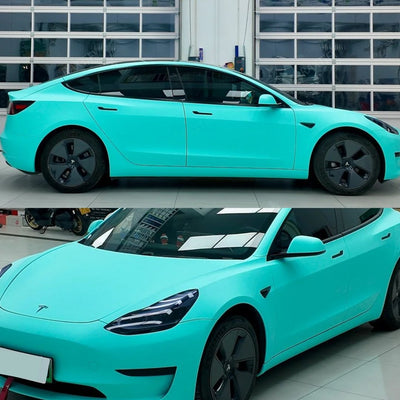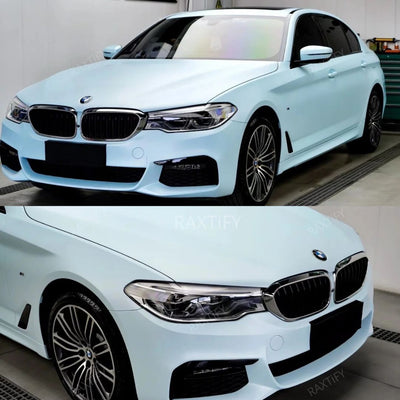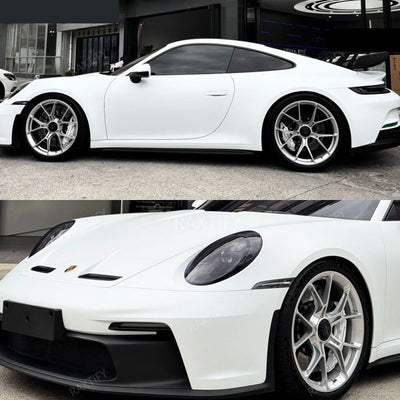
Colored PPF vs Vinyl Wrap. What’s The Difference?
Different Materials
Color-Change Paint Protection Film (PPF) sets itself apart from traditional vinyl wraps by its unique material composition. Unlike vinyl wraps, which typically use cast or PVC (polyvinyl chloride), Color-Change PPF is crafted from TPU (thermoplastic polyurethane). TPU offers exceptional flexibility, durability, and resilience against environmental factors. This ensures prolonged color vibrancy and shields your vehicle's exterior effectively.
By opting for Color-Change PPF over traditional vinyl wraps, you benefit from a material that not only enhances aesthetic appeal but also provides robust protection against wear and tear. Its advanced TPU composition not only maintains the integrity of your vehicle's appearance but also guards against the elements, thereby extending the lifespan of your investment.
Engineered for Paint-Protection
Color-Change PPF offers a distinct advantage over vinyl wrap due to its superior scratch protection. The TPU material used in Color-Change PPF forms a thicker and more durable layer, effectively shielding your car's paint from scratches, swirl marks, and other forms of abrasion. This ensures long-lasting protection for your vehicle's exterior, maintaining its pristine appearance over time.
Extreme Self-Healing Properties
Color-Change PPF is renowned for its impressive self-healing properties. Crafted from TPU, this innovative protective film has the ability to repair surface scratches and imperfections automatically when exposed to heat. This unique capability ensures that your car maintains a flawless finish, extending the lifespan of the protective layer significantly.
Twice the Longevity of A Premium Vinyl Wrap
Cosmetic paint protection film (PPF) can last up to twice as long as traditional vinyl wraps. This extended durability makes color-change PPF a smart investment for maintaining a vehicle’s appearance and resale value. The film's thickness effectively seals the vehicle's paint surface, shielding it from contaminants such as dirt, dust, and pollutants. During regular cleaning, these contaminants can be easily washed away, preserving both the film and the protected paint underneath. This ensures the integrity of your vehicle’s exterior over the long term.
Cosmetic PPF. Here's What to look out for:

Installation Method: Dry Apply vs Wet Apply
1. Dry Apply
When selecting a cosmetic paint protection film (PPF), especially for DIY applications, consider choosing a brand that offers a dry application method. Dry application involves applying the film without the need for water or other solutions, making it simpler and more convenient for DIY enthusiasts. With this method, concerns about excess moisture affecting adhesion or causing bubbles during installation are minimized.
Dry application PPF features air channels that facilitate easy smoothing of air bubbles using a squeegee. This method typically requires fewer specialized tools and allows for easier repositioning of the film during application, ensuring a smoother and more precise result for those tackling the project independently. Moreover, dry application methods often boast shorter curing times, which speeds up the installation process and allows for quicker enjoyment of your newly protected and customized vehicle.
2. Wet Apply
When selecting a cosmetic paint protection film (PPF), especially for DIY applications, consider choosing a brand that offers a wet application method. Wet application involves applying the film with the use of water or other solutions, making it ideal for achieving the best results with color PPF. Only wet application color PPF ensures optimal adhesion and color quality during installation.
Wet application PPF features a special adhesive that requires the addition of water to activate, allowing for better repositioning and ensuring a precise fit. This method typically requires more specialized tools but provides a flawless finish that is essential for high-quality color PPF. Only wet application methods ensure that color PPF maintains its vibrant hue and clarity without any distortion or bubbles, making it the superior choice for those seeking the best aesthetic outcome. Moreover, wet application methods usually offer longer curing times, enhancing the durability and longevity of the film, so you can enjoy a beautifully protected and customized vehicle for years to come.
Tested & Proven Adhesives
When selecting a cosmetic PPF brand, the quality of the adhesives used in the film is crucial. Look for brands that employ tested and proven adhesive formulas specifically designed for cars. These adhesives should be tough, long-lasting, and resistant to factors like sunlight, extreme temperatures, and chemicals found on roads. Also, consider brands that offer certifications or test data demonstrating the adhesive's performance and reliability. This ensures your cosmetic PPF provides dependable adhesion without harming your vehicle's paintwork.
High Quality Finish
When choosing between Color-Change PPF and vinyl wrap, longevity becomes a critical factor influencing your decision. Opting for a high-quality color-change PPF is essential because it ensures a durable finish that maintains its aesthetic appeal and protective qualities over time. Unlike lower-quality alternatives, which may degrade and lose their charm, a superior color-change PPF preserves the beauty of your vehicle while safeguarding it from wear and tear.
To secure lasting beauty and protection, it's crucial to select a reputable manufacturer or installer renowned for delivering top-notch products and craftsmanship. Additionally, inquire about warranties and guarantees to ensure confidence in the durability and performance of your chosen cosmetic PPF. This strategic approach not only enhances the appearance of your vehicle but also provides peace of mind knowing it's well-protected against the elements.
Why Industry Giants Like Tesla Choose Color-Change PPF?

The emergence of color-change Paint Protection Film (PPF) has sparked a revolution in the automotive customization sector, garnering attention from industry giants such as Tesla. This innovative solution not only allows enthusiasts to customize their vehicles without compromising on protection but also addresses the growing concern among car owners to maintain resale value.
PPF is increasingly favored for its ability to safeguard investments while offering a range of unique color options. The use of TPU material in color-change PPF not only boosts durability and self-healing properties but also resonates with the eco-friendly principles embraced by companies like Tesla. TPU is recyclable and biodegradable, reducing environmental impact compared to traditional wraps. This makes it a fitting choice for Tesla and other electric vehicle manufacturers committed to sustainability.
By integrating color-change PPF with TPU material, car owners can now enjoy both personalized aesthetics and enhanced environmental responsibility, ensuring their vehicles are both stylish and eco-conscious.
Final Words
FAQ
Q1. Which is more durable, Colored PPF or Vinyl Wrap?
A: Colored PPF is typically more durable than Vinyl Wrap as it is designed to provide longer-lasting protection, whereas Vinyl Wrap may require more frequent replacement.
Q2. How do the installation difficulties compare between Colored PPF and Vinyl Wrap?
A: Installing Colored PPF is generally more complex than Vinyl Wrap because PPF requires more precise installation to ensure full coverage and protection of the vehicle surface.
Q3. Which is more expensive, Colored PPF or Vinyl Wrap?
A: Colored PPF is usually more expensive than Vinyl Wrap due to higher material and installation costs, whereas Vinyl Wrap is relatively cheaper and easier to install.
Q4. What are the differences in protecting the appearance of a vehicle between Colored PPF and Vinyl Wrap?
A: Colored PPF is primarily used to protect the vehicle's color and appearance from wear and dirt, while Vinyl Wrap can not only provide protection but also change the vehicle's appearance.
Q5. Should I choose Colored PPF or Vinyl Wrap?
A: If you prioritize long-term protection and maintaining the original color of your vehicle, Colored PPF is a good choice. If you want to change the appearance or design of your vehicle in the short term, Vinyl Wrap may be more suitable.
Related Resources:
How Much Does it Cost to Wrap Colored PPF?
The Truth About Paint Protection Film PPF







